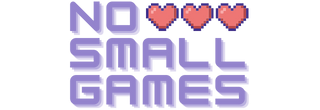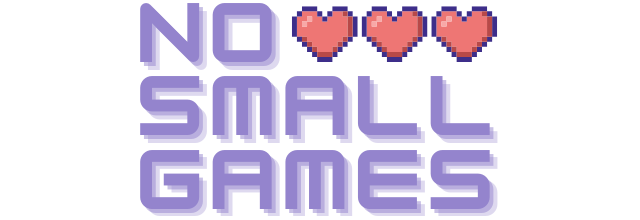
The Deadly Path Review
Succeeding in The Deadly Path is no walk in the park, but it feels much more satisfying.
One look at the Steam store page for The Deadly Path, developed by Owlskip Enterprises, and I knew I was in for a pretty metal time. The vibes ride the line between tastefully cartoonish (in an artistic way that’s reminiscent of Hades) and downright demented, featuring tormented and defiled creatures and gods alike, and all kinds of horrors that you might expect from a Lovecraftian graphic novel. Little did I know the greatest brutalities I would face would be in the demanding gameplay, rather than the visuals.
The Deadly Path looks like a hellish version of Dawnfolk (another 2025 tile-based strategy roguelike), and plays a lot like Sokpop Collective’s Stacklands but with some key differences. During each run, you uncover new tiles, exploring outwards from the locus of your demonic base. Each tile can support one or more building types: mostly resource-generating structures with grotesque names and icons.
A rotating spit of flesh with eyeballs generates meat, a lashing tongue emerging from a pile of skulls generates bone, while a beleaguered golem hunched over a bench grants you gold. You begin with just a few building options, progressively unlocking more as you level up or progress to each phase of the game. Over time, I actually found the artwork weirdly charming, and would get excited to see some of my favorite buildings on a run, like a slice of pie filled with eyeballs. All of these buildings require that you assign some of your monstrous servants to the tile, in order to produce their designated resource type.
The Deadly Path at a Glance
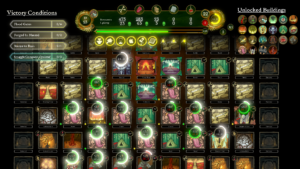
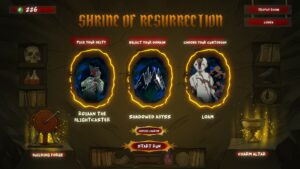
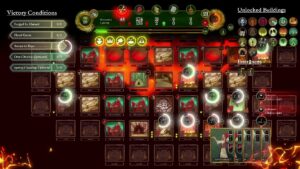
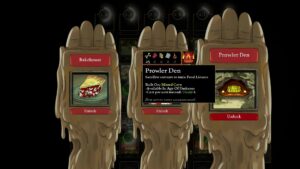
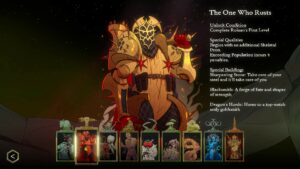
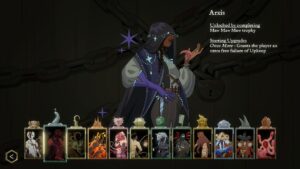
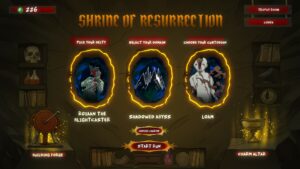
Just like in Stacklands, the resources you gather from these tiles play a critical role at the end of each game loop. Every run in The Deadly Path is divided into a finite number of cycles, each of which ends with an upkeep phase where your Deity demands resources in the form of meat, bone, and gold. Unless otherwise modified, you get one chance to miss your upkeep goals, and on the second failure, the run ends in death.
Players must budget their stash well and monitor resource levels regularly, because almost all other player actions also carry a cost in the form of one or more of these materials. Any thoughtless move, any decision to build an expensive structure too close to the upkeep phase can mean game over. More than once I shocked myself by accidentally dipping into my upkeep budget within seconds of the end of a cycle. The amount of attention I have to spread across so many facets of the gameplay is my ADHD’s best friend and my short term memory’s greatest foe.
Customization for Those Who Earn It
Although the premise of the game remains the same from one run to the next, the game offers significant opportunity for variety in the long term. At the beginning of each run, players select among options for three parameters that will define the goals and abilities at their disposal. Your selected Deity determines which buildings are available to be built during the run, as well as some special buffs or debuffs. The deity also dictates which Domains can be chosen, and the Domain outlines your various win conditions. All required win conditions for the Domain must be met in order to end with success. Lastly, your chosen Custodian grants you a special benefit.
The amount of attention I have to spread across so many facets of the gameplay is my ADHD’s best friend and my short term memory’s greatest foe.
At launch, the game presents you with just a single option for Deity, Domain and Custodian, but clearly displays the conditions required to unlock additional options for each, which I really appreciated. Sometimes there’s surprise and delight in discovering you’ve accidentally unlocked a new character, world, etc. in a game, but in this case I found it really helpful to know what I was working towards. Depending on each player’s success in their first few runs, though, early game can feel a little samey. I had to start over a number of times under all the same conditions as the previous run, which taught me a lot about early game strategy and the importance of picking my level-up rewards wisely. It did feel a bit tedious at times, when the only significant difference between runs was the randomization of tiles on the board.
Trial by Fire
I quickly discovered how apt a name The Deadly Path really is. Success in each run is defined by a set of very narrow conditions, while the game abounds with game-ending pitfalls. Besides failing to meet the upkeep requirements, you can also lose to raiders: armed humans coming in from entrances, ready to overtake your dominion. One of the most devious ways to fail is simply running out of cycles. If you fail to meet all the win conditions by the end of the final turn, that’s game!
I felt a constant tension between the desire to hoard resources to avoid failing upkeep and the anxiety of progressing so slowly that I run out of cycles. In fact, I actually really appreciated the balance between risk taking and careful calculation required here. While I love Stacklands, I found that the lack of urgency makes it easy to stockpile resources and dramatically lowers the stakes. I’m at a point in my latest run where it would require a huge fluke or misstep in order for me to lose. Ultimately, I appreciate both the challenge and the knowledge that each run will come to an end one way or another in The Deadly Path.
While I welcomed the high difficulty level, it was also quite daunting at times. Most of the dominions that I succeeded in conquering took me several runs to beat. I would be lying if I said I didn’t feel occasional frustration after some of my failures. The team at Fireshine Games, publisher for The Deadly Path, do openly acknowledge that this game puts up quite a fight. And fair enough! The folks at Owlskip Enterprises absolutely succeeded at kicking my butt through their dastardly game design. But damn, does it feel good when I finally win a run!
The Deadly Path Trailer
The biggest struggle I encountered, besides the need to balance speed with managing resources, was simply monitoring the board. Most buildings have a limited quantity of whatever resource they produce. At a certain stage in the game, you’re almost constantly rotating minions between various structures. You must reassign your Skeletal Peons, Noxious Ratspawn, and other grotesque lackeys to new buildings to continue your supply chain.
This is all well and good, but over time you unlock a large spread of tiles and the camera will only allow you to zoom out so far. I found myself pausing the in-game clock quite a bit to pan around and survey the status of my map during the latter half of each run. Figuring out which buildings could be constructed next and where I could best assign my creepy crawly employees became my main focus. I also fell prey to raiders multiple times, simply because I couldn’t zoom out far enough to see they were attacking tiles dangerously close to my base. My one petition to the developers would be to allow me to zoom out farther, to get a global, at-a-glance view of the status of my map.
Overall, The Deadly Path will be a dream come true for strategy roguelike fans who are tired of deckbuilders and looking for more urgency and a faster pace in their gameplay. Players should prepare for a significant challenge, though, and limited variation across their first few attempts. For those who stick with it, there’s a huge promise for variation in gameplay style and replayability once they unlock more Deities, Dominions and Custodians. The more I play this game, the more deeply I want to understand it and all its intricacies and strategies, even in the face of occasional frustration.
Get to the point, girl
Emily’s Score: 8/10
Emily was provided with a review key of The Deadly Path by Fireshine Games
About No Small Games
No Small Games is an indie game recap and review podcast brought to you by hosts Kate and Emily! They became friends while streaming on Twitch and bonded over their love of indie video games. In each episode of No Small Games, the two will discuss an indie game they both played independently. They’ll compare their experiences: the good, the bad, their most memorable moments of their playthroughs.
Learn more about the podcast and its hosts on the About page.
